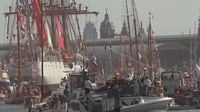Amsterdam’s famed canals have always been a living testament to the city’s seafaring legacy, but on Wednesday, August 20, 2025, they were transformed into a vibrant stage for a spectacle not seen every day. Hundreds of historic ships, each with its own story etched into the wood and canvas, sailed into the heart of the Dutch capital, launching a five-day festival dedicated to Amsterdam’s rich maritime history.
The city’s waterways, already bustling with life, became a parade ground for vessels that have weathered centuries—some with creaking hulls, others gleaming after careful restoration. According to The Associated Press, the flotilla’s arrival marked the official start of the festival, drawing locals and tourists alike to the banks and bridges for a glimpse of nautical grandeur.
It wasn’t just a visual feast; the event pulsed with the sounds of horns, cheers, and the rhythmic slap of water against hulls. The festival, now a cherished tradition, serves as a living museum, reminding Amsterdam’s residents and visitors of the city’s pivotal role in global trade, exploration, and naval innovation. As AP video captured by Aleks Furtula and Ahmad Seir Nassiri showed, the excitement was palpable as the ships processed into the city, their flags fluttering in the summer breeze.
“A flotilla of hundreds of historic ships sailed into Amsterdam on Wednesday to mark the start of a five-day festival celebrating the Dutch capital’s maritime history,” The Associated Press reported, underscoring the scale and significance of the event. The festival’s opening day brought together sailors, historians, and families, all eager to participate in a celebration that bridges the past and present.
Amsterdam’s relationship with the sea is as old as the city itself. Founded in the 13th century as a fishing village, it grew into a bustling port during the Dutch Golden Age, when the Netherlands commanded one of the world’s most powerful navies and merchant fleets. The city’s prosperity was built on maritime trade, with ships carrying spices, textiles, and other goods from distant shores. Today’s festival is a nod to those glory days, offering a rare opportunity to step aboard vessels that once traversed oceans and rivers alike.
For five days, the city becomes a playground for maritime enthusiasts. The festival’s program includes guided tours of the ships, historical reenactments, and workshops on traditional navigation and shipbuilding techniques. There are also lectures from maritime historians, who explain the intricate web of trade routes that once radiated from Amsterdam’s ports, connecting Europe to Asia, Africa, and the Americas.
But it’s not just about looking back. The festival’s organizers hope to inspire a new generation to appreciate the city’s nautical heritage. “We want people to understand how the sea shaped Amsterdam’s identity,” said one event coordinator, echoing the sentiments of many who gathered along the canals. The event is as much about education as it is about celebration, with interactive exhibits designed for children and adults alike.
Visitors can climb aboard classic tall ships, some of which have been lovingly restored by volunteers. These vessels, with their towering masts and intricate rigging, are a testament to the craftsmanship of bygone eras. Many of the ships are open to the public, offering a hands-on experience that brings history to life. For some, it’s a chance to relive childhood dreams of adventure on the high seas; for others, it’s an opportunity to appreciate the engineering marvels that made Amsterdam a world power.
The festival also shines a spotlight on the city’s ongoing efforts to preserve its maritime heritage. Restoration projects, often led by nonprofit organizations and passionate individuals, have saved countless ships from decay. These efforts are supported by the city government, which recognizes the cultural and economic value of maintaining a living fleet of historic vessels. According to The Associated Press, the festival is a testament to the enduring appeal of maritime history and the community’s commitment to keeping it alive.
The event isn’t just for history buffs. Food stalls line the quays, offering traditional Dutch fare—think herring sandwiches and stroopwafels—while musicians perform sea shanties and folk tunes. The atmosphere is festive, with families picnicking on the grass and children waving flags as the ships glide by. For many, it’s a welcome respite from the hustle and bustle of city life, a chance to slow down and savor the simple pleasures of summer.
Of course, the festival also has a serious side. Maritime experts use the occasion to raise awareness about the challenges facing historic ships, from the high cost of maintenance to the threat of climate change. Rising sea levels and increasingly severe storms pose risks not only to the vessels themselves but also to the city’s delicate canal system. Organizers hope that by drawing attention to these issues, they can galvanize support for preservation efforts and ensure that future generations can enjoy the same sights and sounds.
For international visitors, the festival offers a unique window into Dutch culture. Amsterdam’s maritime history is woven into the fabric of the city, visible in its architecture, museums, and even its street names. The festival brings these stories to life, transforming abstract history into a tangible, immersive experience. As one attendee put it, “You can read about Amsterdam’s past in books, but seeing these ships up close makes it real.”
Media coverage has been enthusiastic, with outlets like The Associated Press highlighting the event’s significance. The festival not only boosts tourism but also fosters a sense of pride among locals, many of whom have family ties to the sea. It’s a reminder that, despite the passage of time, Amsterdam’s connection to the water remains as strong as ever.
As the sun set on the festival’s opening day, the ships’ silhouettes cast long shadows across the canals, a fitting symbol of the city’s enduring maritime legacy. For five days, Amsterdam will celebrate the vessels and sailors that helped shape its destiny—an annual tradition that continues to captivate and inspire.




